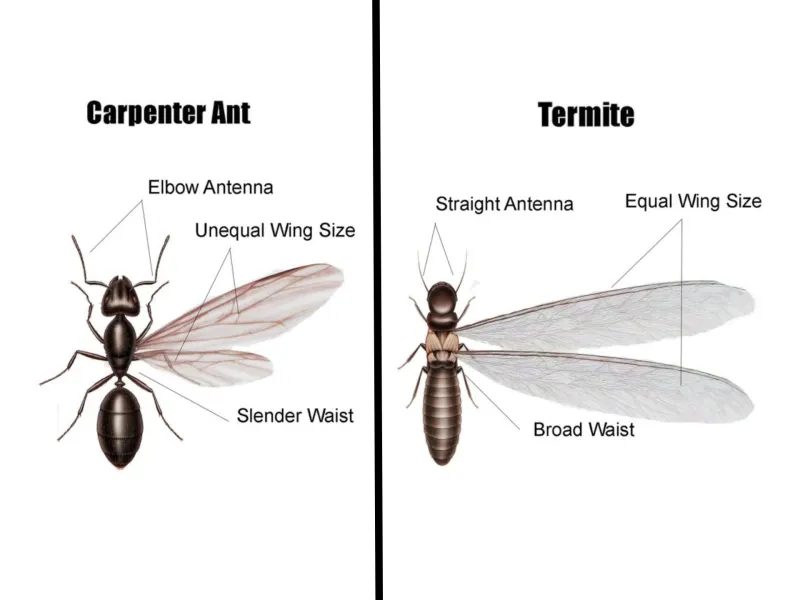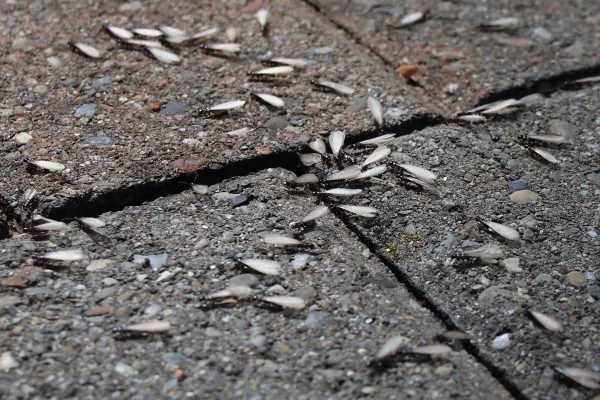Ants or termites: The difference is a big deal

Ants or Termites?
To the untrained eye, the differences between ants and termites are small. However, the impact to your home is quite a big deal. Let’s take a look and see if its ants or termite swarms.
What Are the Characteristics of Ants?
Ants, like termites, are social insects that divide their workloads into divisions of labor. The worker division are the ants you normally see walking about to collect food and water. These workers are protected by soldiers. Ants communicate with each other using their antennae sensing sounds and touch, as well as pheromones passed as chemical signal points. Also like the termite, ants colonies produce reproductive swarmers. The sole purpose of these swarmers is to begin new colonies. Most ant colonies can produce swarmers in as little as a year of colonization. Ants, especially the red imported fire ants, produce reproductive swarmers several times a year. Fire ants are known to have multiple queen colonies, therefore their colonies grow faster and produce larger amounts of reproductive swarmers. Each spring as the weather begins to warm from a cold winter ants, like termites, release their swarmers into nature. Timing is a big key to the confusion of ants or termites.
What Are the Characteristics of Termites?
Termites are social insects as well. Since termites are blind, they do not rely on sight, sounds and touch as much as pheromones. Pheromones guide termites to their trails, food and even alarm termites when something is wrong. Unlike the ant colonies, termites produce reproductive swarmers once per year. Also unlike ants, termites need roughly three years to produce swarmers. Eastern Subterranean Termites usually swarm during early Spring the day after a good rain and when the weather is warmer. Along the coast, Formosan swarmers usually begin at sundown around the Memorial Day weekend.

Eastern Subterranean Termites Swarmers Formosan Termite Swarmers
What Are the Differences Between Ants and Termites?
While both ants and termites are social insects that produce reproductive swarmers, there are several key differences in identifying the insects.
The first noticeable difference in comparison are the wings. The ant and termite both have two pair of wings. However, the ant wings are two distinct pair containing two sizes of wings with a more defined vein pattern and wing structure. Termites have two sets of wings as well, however, all four wings are the same size. When the wings are at rest and covering the body, the wings are almost double the size of the body of the termite. In addition, the wings do not have the same defined wing structure as the ant.
Next, the body. Ants have three distinguished segmented body parts with a pinched abdomen. Termites contain no distinguished segmented body parts.
Third is behavior. Since termites shed their wings once they have found an appropriate spot, it is often hard to tell the insect by wings alone. Normally you will see a queen termite being followed extremely close by the king termite. Since the swarmers’ sole purpose is to start a new colony in the appropriate conditions, termites waste no time pairing up and find that perfect spot to nest.
Finally, the forked versus non forked antennae. You have to examine this feature really closely, however, it is truly distinguishing. Ants have forked antennae. Forked meaning the antennae leave the head at 90 degrees, then sharply turn 90 degrees again. Termite antennae are simply attached to the head and are fairly straight.
Damage
In closing, both insects are pests and are crucial to the environment, but should never enter or live close to your home. While ants are pests, very few of their species are capable of significant damage to your structure. Termites on the other hand account for over 5 billion dollars in damage to US homeowners – damage that is not covered by homeowners’ insurance. Knowledge and identification are key in determining which winged insect you are looking at.
Palmetto Exterminators’ employees are vigorously trained to spot whether the insects are ants or termites. Call or contact your local termite exterminators today for a free inspection and termite protection quote.



